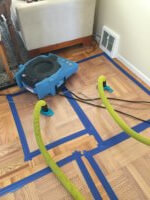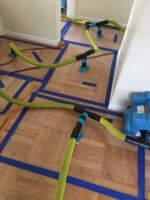Effects of Flooding on Flooring
Floods can cause a lot of damage to property and structures. While the damage may affect all parts of a structure, the floors often tend to bear the brunt of the water because water will completely cover the floor before it starts rising.
Types of Flooring
Different types of flooring will be affected by flood water differently. It is a common belief that some flooring types are never affected by flooding. This is often said about hardwood flooring that is believed to be water resistant. While some floors may not show signs of water damage immediately, there could be consequential problems at later stages, long after the flooding event has passed. 
Hardwood floors have a higher resistance to water damage while the softer woods may not have much tolerance against flood water and will soak it up much faster. Hardwood floors will absorb up to a certain amount, 10% of their weight, of water once they have been exposed.
Some of the most common effects that flood water will have on flooring include:
 Breaking down of the flooring glue. This is especially common when the floor planks have been held down by glue. Water will cause the glue to come off and in turn the planks will become disconnected. Disconnected planks will let in more water through the newly exposed spaces, causing further problems.
Breaking down of the flooring glue. This is especially common when the floor planks have been held down by glue. Water will cause the glue to come off and in turn the planks will become disconnected. Disconnected planks will let in more water through the newly exposed spaces, causing further problems.- Swelling of wooden planks is yet another problem that can result from flooding. Swollen planks are a recipe for an uneven floor which can be uncomfortable to walk on.
- Buckling and expansion of planks is yet another effect of flooding. The wooden planks, after absorbing flood water, may start having ripples around the edges. These ripples may also cause the surfaces of the floor to be uneven, creating a falling hazard.
- Cupping of the plank edges as a result of absorbing water. The planks may tun up at the ends distorting their regular shape and the evenness of the floor
- Molding is yet another effect of flooding. Any wetness within the wooden planks will cause mold to start growing under the floor and this might spread into other parts of the house too. This can cause further damage around the house as well as pose a health risk to the people and pets around the house
How exactly would one prevent excessive damage to floors in case of flooding? There are a few steps that can be taken to ensure that the flooring remains intact following a flood. These steps all start from removing excess moisture from the flooring as soon as possible. The longer flood water remains on the floor, the less likely it is that you will be able to salvage the flooring. Calling in professionals to dry out the flooring as soon as possible will save the situation.
As part of removing the moisture from the floor, you will need to thoroughly dehumidify the floor in order to suck out any moisture that may not have dried out by itself. This is the moisture that if left lingering may bring on further issues such as molding. Dehumidification will ensure that the floor is completely moisture free. Taking out any planks that may have been badly affected and replacing them will also ensure that the flooring remains even and in good shape.
At Allied Restoration, we offer water damage repairs and restoration services that will ensure that you can salvage as much of your property as possible following a flood. This includes state of the art rescue mats that are meant for the flooring of your house. We have the equipment and knowledge that is needed to ensure that the flooring is well taken care of in the disaster mitigation process.
